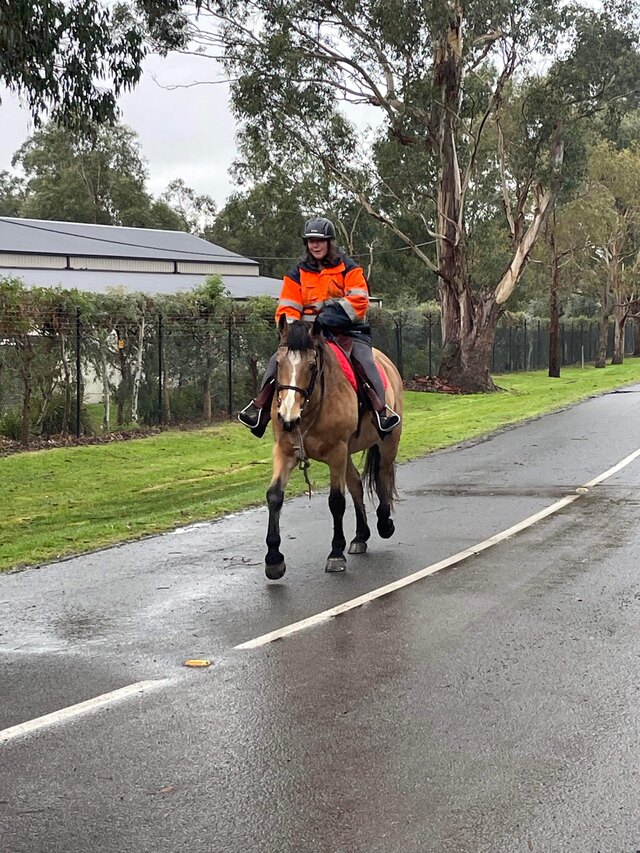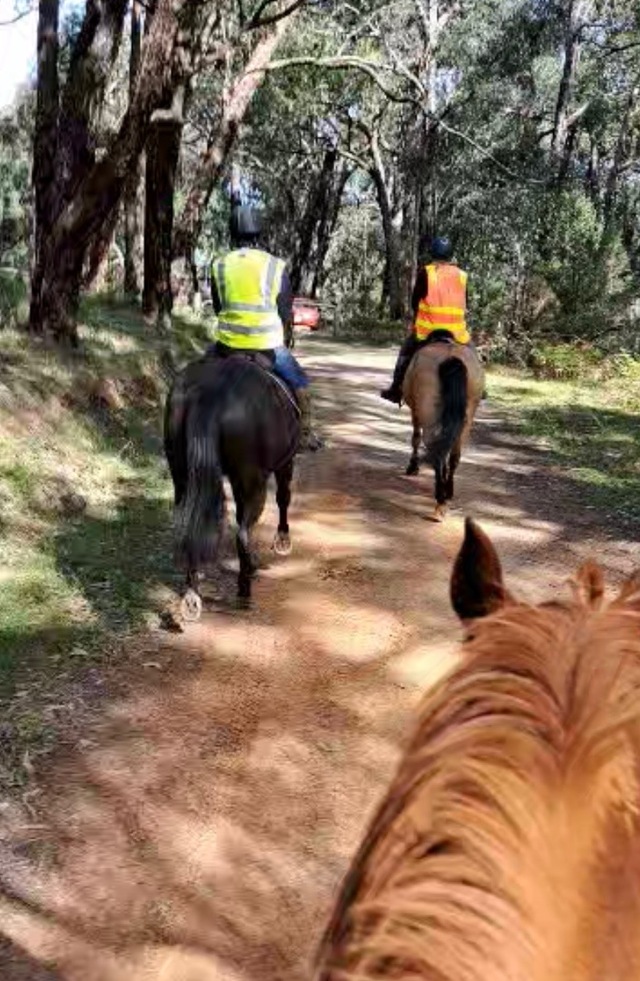Humans, horses, and bicycles have recently created some near misses for a local horse rider from The Basin.
Horse Riding in the Doongalla area within the Dandenong Ranges National Park has created concerns over the future of horse riding as bikers and horses try to safely share space.
A local trail riding business operation also remains in question in the same area.
Long-time horse rider Andrea Blake keeps her horse George on agistment in The Basin and regularly rides along the Doongalla road through to the nothern part of the Donngalla Picnic Ground.
On Sunday 4 August Ms Blake, horse George and two friends with their horses were out for a Sunday ride when the group had a number of encounters with bikers on the trails.
“We had a lady coming up the hill, very fast, around the corner on a bike and that was the first fright for the horses,” she said.
“About three minutes later, we could see two other bike riders coming down the track through the trees,” she said.
“They pulled up as soon as they saw the horses reacting.”
Over social media, Ms Blake thanked the riders for pulling up as they are required to but said she is concerned that without proper awareness situations with horses and bike riders may not end well.
Dandenong Ranges Trail Rides, also known as Smallacombe’s riding school recently closed its operations until further notice, as they search for an affordable insurance provider to cover them for the rides through the popular area.
As of the weekend of 2 July, the business has closed operations, having its last trail ride that weekend.
Ms Blake said she prefers the horse trails around Doongalla because it is so close to where her horse resides and she doesn’t have to transport George via a float.
“It’s the closest place and the only place I can ride in the bush or off the road in this whole southeastern region unless I float,” she said.
“It’s a really good fitness thing to ride up the hills and good for them [the horses],” she said.
Some agistment arrangements will allow horses to ride on the property they live on, but not all.
Andrea said her only choice with George is to ride out a gate onto a road by traffic at a kilometre and a half down the road.
Riding a horse on the road is legal but Ms Blake prefers weekends due to traffic.
“You get on a track where you think you’re going to be safe and even then you’re not safe,” she said.
“We’re having a clash between these user groups and my point would be, there are designated areas for mountain bikes and you would never find a horse rider on those tracks.”
“Why can’t we have somewhere safe?”
With fewer local areas for her to ride on, Ms Drake said she would like bike riders off the Doongalla trails or some more awareness around the shared space.
Dandenong Ranges National Park provides around 22km of horse riding trails, within or adjacent that run through the Doongalla area and Silvan Road near Silvan Reservoir.
Other shared trails like the Warburton trails are more open and bike riders can be seen from a distance.
“You’re not locked in as much as you are up a mountain track like Doongalla. It’s fairly tight in there,” said Ms Drake.
“I do not ride on non-horse tracks. I don’t deviate from tracks unless I’m safe on the track.”
Ms Drake is concerned bike riders are unaware that there are horse tracks there.
“My question is do bike riders even know they are horse tracks? Unless they’re either signed or there’s a map showing that they are,” she said.
Ms Drake said horse riding is part of the culture and Australia’s colonial history is embedded with horsemanship.
“Horses helped us build,” she said.
“There’s a lot of skill still around that’s been passed down. To maintain it as a skill. We need to be able to practice it.”
Parks Vic said that current permitted locations for horse riders in the Dandenong Ranges National Park include a number of tracks in The Basin, near the Sherbrooke and Grants Picnic Grounds in Kallista, Sassafras and the Silvan Reservoir in Olinda.
Horses are not permitted in any other areas of the park, including the picnic grounds and mountain bike riders must wear a helmet, ride at a safe speed, keep to the left, warn others when they are approaching and move off the trail when they come to a stop.
Ms Blake said that having areas that can be ridden to like the northern trails of Doongalla, without the need for a float is also vital for riders from a financial perspective.
“The danger is we lose it all together, right? And that is just, that would be just the worst, worst outcome. It’d be the end of casual riding for a lot of people,” she said.








